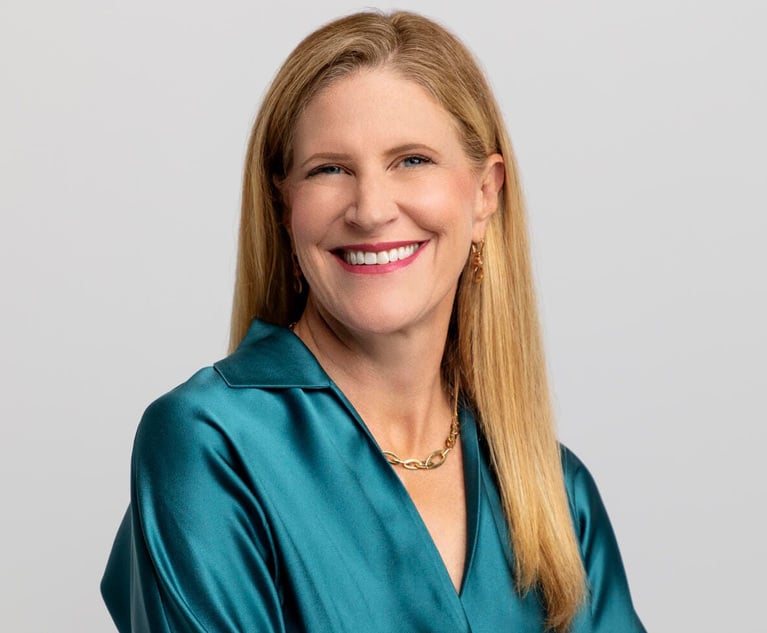IP: Hidden traps: Introduction to subject matter conflicts in patent prosecution
Ignoring subject matter conflict searches can create mountains of problems down the road ranging from allegations of inequitable conduct to patent invalidity.
January 14, 2014 at 03:00 AM
6 minute read
The original version of this story was published on Law.com
Clearly, client-driven litigation and malpractice complaints against patent practitioners are not decreasing any time soon. During the investigation surrounding the suit or complaint, the actions or inactions of the patent practitioner are reviewed in detail and the practitioner subject to scrutiny. One area that appears ripe for concern is the review and addressing of conflicts of interest.
Attorneys who have been practicing for more than a day are familiar with the process of conflicts of interest searches. A new client comes into the office or firm, the attorney or conflicts team searches a client database for the name of the person or entity. If a potential conflict surfaces, the conflict must be cleared, waived or the client sent elsewhere. As law firms merge and attorneys move from firm to firm, conflict of interest searches become important considerations. Are companies doing all they can to ensure that outside counsel is properly handling conflicts of interest?
The issue is not only ensuring that the prospective patent clients don't present conflicts with one another, but also ensuring that their patent applications don't present conflicts. A subject matter conflict search is equally as important as an entity/individual conflict search. This type of additional search is not related to the inventors, assignee or research team but is directly related to the patent application disclosure. Ignoring these searches can create mountains of problems down the road ranging from allegations of inequitable conduct to patent invalidity.
This article introduces the problem of subject matter conflicts of interest in patent prosecution work. The five articles that follow in this series will discuss relevant case law, recent and important issues and practical methods to minimize this particular conflict.
Patent applications contain the disclosure of an invention and the related embodiments and examples of that invention. The key to each patent application is the claims. When a patent application is filed with the United States Patent & Trademark Office or a foreign patent office, an examiner reviews it, searches the subject matter and may issue an Office Action outlining any procedural issues and presenting rejections based on nonstatutory subject matter (such as software), lack of novelty or nonobviousness. Lack of novelty and nonobviouness rejections are usually based on one or more other patent applications, issued patents, journal articles or other public disclosures. The attorney representing the inventor or assignee must then successfully argue around those references, amend the claims or both, in order to advance the application to allowance.
As an example, you represent a large company and handle all of their patent applications related to shelf-stable cream cheese. A current or prospective client sends a patent disclosure to the firm that includes a novel shelf-stable fresh soup. While one may be related to dairy products and the other to something that may not contain dairy, is the process or ingredients that make them both shelf-stable the same or similar? Do you review the disclosure to determine whether it overlaps with Large Client's patent applications? If another attorney at the firm gets the new disclosure, do you have a review process in place to make sure that the new disclosure is checked against current patent applications being handled by the firm? If you file the application on the shelf-stable fresh soup, do you run the risk of having patent applications or patents from the Large Client cited against your new client's application?
When I work with clients who have recently lost inventors to other companies/competitors, the question always comes up: What can we do about the fact that he/she is using our trade secret information to help our competitor? The answer to that question is not simple. A chemist doesn't know where he/she first learned how to maximize the yield of a particular compound during synthesis – it just becomes part of the bulk of his/her knowledge. The same can be said for patent practitioners. If you spend a great deal of time preparing food additive patent applications for Large Client, do you turn that knowledge off when you draft a food additive patent application for a new client? Do you pull your punches and not include language used to describe those materials in general when drafting the second application? Do you include references to Large Client's patents and patent applications in the background of the new application? If you do that, how do you walk the tightrope of distinguishing the subject matter of the new application over Large Client's patents without disparaging Large Client's patents? If the new client is a solo inventor, do you work harder to get Large Client's patent applications allowed? I contend that although you believe you can effectively represent both entities – you shouldn't.
A better question to ask in this type of situation is whether a firm representing competitors in patent or other types of matters can diligently prosecute patents for each. The firm may jump through every hoop and keep everything above board when handling both clients, but there will always be “the appearance of impropriety” when looking back on the matters. If you didn't submit a reference through an information disclosure statement for one client, did you honestly believe that the reference wasn't relevant or did you fail to submit it based on an attempt to protect the patent of the other client? If your client asks you to seek reexamination of a competitor's patent, are you able to do so or do you have to explain to your client that you or your firm is handling the other patent? Regardless of your belief at the time that everything was handled correctly, a former client can certainly make a case for inequitable conduct or malpractice, based on the mere appearance of impropriety.
In a rapidly changing economy, in-house counsel may consider moving all work to one firm to simplify communications and billing; however, this decision should be carefully considered and homework should be done. Given the stakes that surround key innovations in certain fields, companies must be diligent in asking about subject matter conflicts of interest. The next three articles in this series will address some of the relevant case law in this field of conflicts and how to practically deal with these developments.
This content has been archived. It is available through our partners, LexisNexis® and Bloomberg Law.
To view this content, please continue to their sites.
Not a Lexis Subscriber?
Subscribe Now
Not a Bloomberg Law Subscriber?
Subscribe Now
NOT FOR REPRINT
© 2025 ALM Global, LLC, All Rights Reserved. Request academic re-use from www.copyright.com. All other uses, submit a request to [email protected]. For more information visit Asset & Logo Licensing.
You Might Like
View All
Former Capital One Deputy GC Takes Legal Reins of AIG Spinoff

Legal Departments Dinged for Acquiescing to Rate Hikes That 'Defy Gravity'
4 minute read
Apple Disputes 'Efforts to Manufacture' Imaging Sensor Claims Against iPhone 15 Technology
Trending Stories
Who Got The Work
Michael G. Bongiorno, Andrew Scott Dulberg and Elizabeth E. Driscoll from Wilmer Cutler Pickering Hale and Dorr have stepped in to represent Symbotic Inc., an A.I.-enabled technology platform that focuses on increasing supply chain efficiency, and other defendants in a pending shareholder derivative lawsuit. The case, filed Oct. 2 in Massachusetts District Court by the Brown Law Firm on behalf of Stephen Austen, accuses certain officers and directors of misleading investors in regard to Symbotic's potential for margin growth by failing to disclose that the company was not equipped to timely deploy its systems or manage expenses through project delays. The case, assigned to U.S. District Judge Nathaniel M. Gorton, is 1:24-cv-12522, Austen v. Cohen et al.
Who Got The Work
Edmund Polubinski and Marie Killmond of Davis Polk & Wardwell have entered appearances for data platform software development company MongoDB and other defendants in a pending shareholder derivative lawsuit. The action, filed Oct. 7 in New York Southern District Court by the Brown Law Firm, accuses the company's directors and/or officers of falsely expressing confidence in the company’s restructuring of its sales incentive plan and downplaying the severity of decreases in its upfront commitments. The case is 1:24-cv-07594, Roy v. Ittycheria et al.
Who Got The Work
Amy O. Bruchs and Kurt F. Ellison of Michael Best & Friedrich have entered appearances for Epic Systems Corp. in a pending employment discrimination lawsuit. The suit was filed Sept. 7 in Wisconsin Western District Court by Levine Eisberner LLC and Siri & Glimstad on behalf of a project manager who claims that he was wrongfully terminated after applying for a religious exemption to the defendant's COVID-19 vaccine mandate. The case, assigned to U.S. Magistrate Judge Anita Marie Boor, is 3:24-cv-00630, Secker, Nathan v. Epic Systems Corporation.
Who Got The Work
David X. Sullivan, Thomas J. Finn and Gregory A. Hall from McCarter & English have entered appearances for Sunrun Installation Services in a pending civil rights lawsuit. The complaint was filed Sept. 4 in Connecticut District Court by attorney Robert M. Berke on behalf of former employee George Edward Steins, who was arrested and charged with employing an unregistered home improvement salesperson. The complaint alleges that had Sunrun informed the Connecticut Department of Consumer Protection that the plaintiff's employment had ended in 2017 and that he no longer held Sunrun's home improvement contractor license, he would not have been hit with charges, which were dismissed in May 2024. The case, assigned to U.S. District Judge Jeffrey A. Meyer, is 3:24-cv-01423, Steins v. Sunrun, Inc. et al.
Who Got The Work
Greenberg Traurig shareholder Joshua L. Raskin has entered an appearance for boohoo.com UK Ltd. in a pending patent infringement lawsuit. The suit, filed Sept. 3 in Texas Eastern District Court by Rozier Hardt McDonough on behalf of Alto Dynamics, asserts five patents related to an online shopping platform. The case, assigned to U.S. District Judge Rodney Gilstrap, is 2:24-cv-00719, Alto Dynamics, LLC v. boohoo.com UK Limited.
Featured Firms
Law Offices of Gary Martin Hays & Associates, P.C.
(470) 294-1674
Law Offices of Mark E. Salomone
(857) 444-6468
Smith & Hassler
(713) 739-1250







